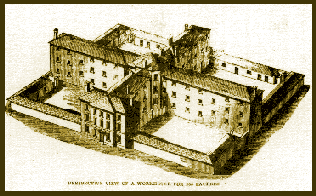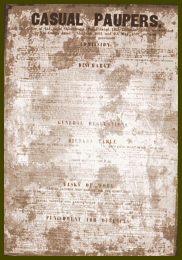|
|
|
|
|
|
|
|
|
|
|
|
|
|
|
|
|
|
|
|
|
|
|
|
|
|
|
|
|
|
|
|
Return to Mullins home page Sign Guestbook View Guestbook
Workhouses were stark, drab prison-ilke structures aimed at discouraging people from claiming poor relief and conditions were to be made as forbidding as possible. High walls surrounded the whole workhouse in an attempt to cutt off the view of the outside world from the inmates. Windows were usually about six feet from the floorwith window sills sloping downwards, preventing them from being used as seats of shelves. Heating was usually inadequate making for a cold, damp atmosphere. Workhouses contained dormitories, washrooms, workrooms, a 'refractory ward' (solitary confinement), the mortuary, bake-house, receiving wards, dining halls and a chapel. The stairs were a hazard and any sick or old person housed on the upper floors would be virtually a prisoner. Space was usually at a premium. Too many people were crammed into the smallest space possible: for example, eight beds could be put into a narrow dormitory only sixteen feet long; thirty-two men were put into a dormitory 20 feet long; ten children and their attendants were put into a room 10 feet by 15 feet.
There were seven main groups of inmates:
The seven groups were to be kept totally separated at all times, even during 'leisure' time. Married couples, were to be kept apart at all costs so that they could not 'breed'. Each of the seven classes was supposed to have its own exercise yard. This meant that the old, ill, insane, slightly unbalanced and fit were kept together both day and night with no form of diversion. Inmates simply sat and did nothing if they were not working.
The hospital ward took in all cases, so at any one time there may have been patients suffering from any variety of complaints ranging from broken legs, measles, typhoid fever and smallpox to blindness, scarlet fever, diphtheria and dysentery.
The basic furniture was a cheap wooden bed with a flock-filled sack as a mattress. Two or three blankets were provided but no pillows or sheets. Most people shared a bed; the beds were arranged as in a barracks - two rows of bunks. Other furniture included wooden stools or benches and wooden tables. Few seats had arms or back-rests and none were upholstered. The walls were papered with lists of rules or Bible passages telling the inmates how lucky they were ('Blessed are the poor ...'), official diet lists and more rules. There were no newspapers, no books, no toys, no games or any other forms of recreation.
The daily routine, set down by the 1834 Act was:
|
5.00 a.m. |
Rising bell |
|
6.00 a.m. - 7.00 a.m. |
Prayers and breakfast |
|
7.00 a.m. - 12 noon |
Work |
|
12 noon - 1.00 p.m. |
Dinner |
|
1.00 p.m. - 6.00 p.m. |
Work |
|
6.00 p.m. - 7.00 p.m. |
Prayers |
|
7.00 p.m. - 8.00 p.m. |
Supper |
|
8.00 p.m. |
Bed |
'Work' consisted of oakum-picking, stone-breaking, bone-crushing, sack-making or driving the corn mill. Oakum is old rope, sometimes tarred or knotted. These ropes had to be unpicked inch by inch and a day's work would be to unravel 3 lbs. of rope. The corn mill was driven by inmates walking round on a treadwheel. Women had to do domestic work: scrubbing floors that were already clear, polishing brasses, scrubbing table tops, black-leading kitchen ranges and so on.
On admission, an inmate's clothes were removed and stored. S/he was searched, washed, had his/her hair cropped and was given workhouse clothing. This consisted of, for a woman : a shapeless, waistless dress which reached the ankles, made of striped (convict-style) fabric, a shapeless shift, long stockings and knee-length drawers. She also was given a poke-bonnet. A man was given a striped shirt, ill-fitting trousers (the length being adjusted at the knee with a piece of string), thick vest, woollen drawers and socks, a neckerchief and (in winter) a coarse jacket. Children were similarly dressed. All the inmates were given hob-nailed boots.
Meals were dull, predictable and tastelessand the quantity, quality and lack of nutrition meant that workhouse inmates were on a slow starvation diet.
The workhouse or starvation
The
Poor Law Amendment Act
of 1834 also decreed that external relief for
the poor was to be stopped within two years, leaving these unfortunates with the
choice of the workhouse or starvation. The legislation had been
designed to root out the "undeserving poor", but it was the genuinely
deserving and most needy members of society who suffered most because of
it.
Because of the levels of hostility to the new regimes, help for the poor outside the workhouse system was still carried out. After 1850 the workhouses mostly contained the "deserving poor", plus a shifting population of vagrants and "casual paupers" kept apart from the others.
The workhouse system
By the end of
the 17th century the workhouse system was becoming well established, and
the General Workhouse Act of 1723 gave parishes the authority to
build their own workhouses or join with other parishes to do so.
Expenditure on the poor had been steadily rising in the late 18th and early 19th centuries, along with the rise in the general population, and the combination of the workhouse system plus outside help, in the form of money or essential provisions, was placing ever greater demands upon the poor rate.
 A spartan regime for desperate
people
A spartan regime for desperate
peopleSeparating families
One of the cruellest aspects was the practice of separating husbands and
wives and parents and children. Not
only were they forced to stay in different parts of the workhouse, but
they were not even permitted to meet in the communal areas such as the
chapel.
Tasks of Work.
 Casual Paupers
who are detained for more than one night:
Casual Paupers
who are detained for more than one night:
As regards Males, for
each entire day of detention -
The breaking of seven cwt. of
Stones, or other such quantity not less than five cwt. nor more than
thirteen cwt. as the Guardians having regard to the nature of the Stone,
may prescribe. The stone shall be broken to such a size as the Guardians,
having regard to the nature thereof, may prescribe; or
The picking of
four pounds of unbeaten or eight pounds of beaten Oakum; or
Nine hours'
work in digging or pumping, or cutting wood, or grinding corn.
As regards Females, for each entire day of detention
-
The picking of two pounds of unbeaten or four pounds of beaten
Oakum; or
Nine hours' work in washing, scrubbing and cleaning, or
needlework.